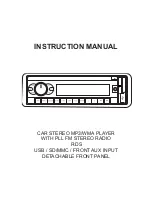
Preventive Maintenance
49
Cat. No. 01024000
Double Regenerating the Cation Resin
The primary cause of hardness leakage or premature sodium leakage from the cation column is lack of regenerant. This
may be due to low water pressure, blocked draw tubing, or low level of acid in the chemical container. First determine
the cause for low acid usage and correct it. Once the problem is corrected, the resin can be restored to peak capacity by
overdosing with acid.
1. Reset the acid draw time to double the normal time.
2. Initiate a regeneration and allow system to advance through regeneration normally. This will draw twice the
amount of acid and allow twice the normal contact time. The decationized water after regeneration should be
between 2.5 and 3.0 pH and 0.0 hardness.
3. If the cation has leaked hardness to the anion column, it must also be acidized.
Removal of Hardness from the Anion Resin
Leakage of hardness from the cation column can foul the anion resin. If poor quality is experienced from the deionizer,
check the hardness of the decationized water. This may be the cause for poor quality. Other causes may be attributed
to the lack of Sodium Hydroxide (Caustic Soda) such as low water pressure, cold caustic soda, or low chemical. The
hardness can be removed from the anion resin by regenerating it with acid. The following procedures should be followed
to accomplish this.
1. Connect the acid draw hose to the anion chemical feed pump and perform a manual regeneration of the anion
column.
2. Drawing acid into the anion column, which contains sodium hydroxide, will cause the release of carbon dioxide.
Do not stop the regeneration in the middle of the cycle—the CO
2
must be allowed to escape! Some heat may
also be noticed and gurgling sounds from inside the tank, this is normal.
3. Allow the Anion to continue through regeneration. When rinse is complete advance the system to service.
Reconnect the acid draw hose to the cation feed pump and reconnect the caustic draw hose to the anion feed
pump.
4. Initiate a normal regeneration. Monitor the acid and caustic to insure proper amounts of chemical are used for
regeneration.
The length of time necessary to restore the anion resin’s performance depends on the degree of fouling. It may be neces-
sary to allow the unit to sit overnight with the acid in it. Follow the steps below to accomplish this.
1. Connect the drawtubes as previously described. After the acid is drawn, allow the Anion column to rinse for 2
minutes, then turn off the water and remove the fill plug from the top of the tank. Venting the tank in this manner
will allow the CO2 to escape while the system is sitting.
2. Turn “off” the control and allow the system to sit over night. A minimum of 8 hours is recommended.
3. Connect the drawtubes back to their proper positions. The acid should be connected to the cation column and
the caustic soda should be connected to the anion column.
4. Replace the fill plug and slowly pressurize the system. Turn “on” the control panel and advance the anion col-
umn into the rinse cycle. Rinse the anion column for 60 minutes.
5. Advance the control to the beginning of the regeneration cycle (Cation Backwash) and allow the system to
regenerate normally.
After the regeneration, if the quality fails to return, the resin may be beyond salvage or it may be past its normal service
life of three to five years. In either case, the resin should be replaced. A sample of the resin may be sent to the Culligan
water lab for analysis (there is a fee involved with this, refer the
page on CPort (www.cport.culli-
gan.com) for specific pricing information).
















































